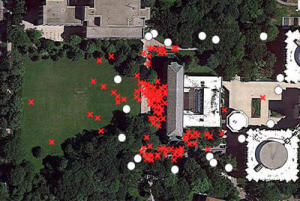It looks like you're using an Ad Blocker.
Please white-list or disable AboveTopSecret.com in your ad-blocking tool.
Thank you.
Some features of ATS will be disabled while you continue to use an ad-blocker.
Using Virtual Worlds to 'Soft Control' People's Movements (not just location) in the Real One
page: 11
share:
Tie in this thread...
The NSA Is Building the Country’s Biggest Spy Center
...with this story posted on Science Daily and the picture that is being painted these days (at least in my mind's eye) is not something that I would consider liberty. In fact, it is becoming more and more a gross invasion of privacy by utilizing these devices that most people have become all but dependent upon. But hey, if it's in the name of science that makes it okay I guess.
(I added bold emphasis to the part that I felt was a bit disturbing)

Now this section of the article is even scarier imo (again bold emphasis added)
So until they are able to force us without the use of these so called incentives this is apparently what is to come. Perhaps the day when the incentive will be the food you eat or perhaps the air that you breathe are not too far down the road. Understood, I am taking a cynics view of this new tech but with the way the world operates I don't foresee the intended nature of this tech being for the greater good of the human collective.
Despite my view, I present this to ATS for discussion.
Full Science Daily Article
The NSA Is Building the Country’s Biggest Spy Center
...with this story posted on Science Daily and the picture that is being painted these days (at least in my mind's eye) is not something that I would consider liberty. In fact, it is becoming more and more a gross invasion of privacy by utilizing these devices that most people have become all but dependent upon. But hey, if it's in the name of science that makes it okay I guess.
(I added bold emphasis to the part that I felt was a bit disturbing)
ScienceDaily (Mar. 16, 2012) — Eighty-eight percent of Americans now own a cell phone, forming a massive network that offers scientists a wealth of information and an infinite number of new applications. With the help of these phone users -- and their devices' cameras, audio recorders, and other features -- researchers envision endless possibilities for gathering huge amounts of data, from services that collect user data to monitor noise pollution and air quality to applications that build maps from people's cell phone snapshots.

An overhead view of the Charles Deering Library at Northwestern University. White dots represent photos taken by Ghost Hunter players who had been "soft controlled"; red X's represent photos taken and shared on Flickr. (Credit: Image courtesy of Northwestern University)
Now this section of the article is even scarier imo (again bold emphasis added)
Researchers can't force mobile users to behave in a certain way, but researchers at Northwestern University have found that they may be able to nudge them in the right direction by using incentives that are already part of their regular mobile routine.
"We can rely on good luck to get the data that we need," Bustamante said, "or we can 'soft control' users with gaming or social network incentives to drive them where we want them."
So until they are able to force us without the use of these so called incentives this is apparently what is to come. Perhaps the day when the incentive will be the food you eat or perhaps the air that you breathe are not too far down the road. Understood, I am taking a cynics view of this new tech but with the way the world operates I don't foresee the intended nature of this tech being for the greater good of the human collective.
Despite my view, I present this to ATS for discussion.
Full Science Daily Article
Here is another interesting tidbit from the article...
This to me, has MK Ultraesque undertones to it, "soft control". I think of games like Farmville and other facebook games that I have witnessed people become virtually addicted to.
What would one do or where would one venture to gain an item or status in a game that was played by a multitude of the masses. People get serious about these games.
To test crowd soft control, the researchers created Android games, including one called Ghost Hunter in which a player chases ghosts around his neighborhood and "zaps" them through an augmented reality display on his phone. In actuality, the player's zapping motion snaps a photo of the spot where the ghost is supposedly located.
Unlike a regular "augmented reality game," where the ghosts might be placed randomly, in Ghost Hunter the researchers are able to manipulate where the ghosts are placed; while some are placed in frequently traveled areas, others are located in out-of-the-way, rarely photographed locations.
This to me, has MK Ultraesque undertones to it, "soft control". I think of games like Farmville and other facebook games that I have witnessed people become virtually addicted to.
What would one do or where would one venture to gain an item or status in a game that was played by a multitude of the masses. People get serious about these games.
new topics
-
A fix for the Trans players in sports
Social Issues and Civil Unrest: 1 hours ago -
Petition Calling for General Election at 564,016 and rising Fast
Political Issues: 4 hours ago -
Rep. Alexandria O. Cortez Says Forcing People to Use The Correct Bathroom is Dangerous.
US Political Madness: 10 hours ago -
Cooperation zones
World War Three: 11 hours ago
1
